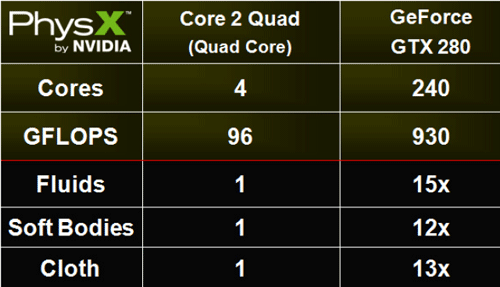NVIDIA GPU PhysX Pack Preview
Introduction

Physics: as geeks, we just have to love the subject. We loved learning about geniuses like Isaac Newton and concepts like gravity, acceleration and inertia. Also, typical of geeks, we love gaming. So, combining physics acceleration and gaming just sounds like a really cool idea. For the past several years, we've been learning more and more about physics in gaming in the form of PhysX, a technology created by a company called Ageia. The original approach to PhysX by Ageia was a dedicated PhysX card that sported a PPU (physics processing unit). Ageia partnered with companies like BFG and ASUS to bring the PhysX cards to market. We actually reviewed the BFG version here in the HotHardware labs over two years ago. The entire real-time, in-game physics landscape has changed quite a bit since that time, however. With NVIDIA's relatively recent acquisition of Ageia, we all knew it was only a matter of time before we'd see some kind of announcement or launch detailing what NVIDIA's plans were with the PhysX technology.
We've already seen some information on PhysX with regards to 3DMark Vantage and Unreal Tournament 3. Today, we get to take a glimpse into what else NVIDIA has been up to with PhysX, which, according to NVIDIA, is "the most popular physics API in the world with over 140 shipping titles across all major platforms, including the PC, Wii, Xbox360, and Playstation 3." At the heart of the PhysX technology lies the claim that in-game physics leads to more realistic gameplay. We can't help but agree with that claim. Just think about how enjoyable rag-doll physics has been over the last several years. Picking up and throwing a Combine soldier with the gravity gun in Half-Life 2 just wouldn't be the same without some physics calculations going on in the background. With PhysX, though, NVIDIA hopes to take things to all new levels, of course, by utilizing the tremendous computing power of the GPU, rather than relying on the CPU.

Keep in mind that PhysX isn't just about making games look better; it's about making seem more realistic and less scripted. PhysX adds realism by making game environments behave closer to how they would in real life. Because so many calculations have to happen at once to create realistic physics effects, real-time physics in games is a multithreaded problem, which means that having more processing cores to throw at the problem will result in more physics effects that can be added to games. This is why NVIDIA is moving physics calculations to the GPU. According to NVIDIA, you need to use a GPU in order to produce more advanced physics effects, like snow accumulation or real-time dynamic flooding.

NVIDIA PhysX is currently the only in-game physics engine for the PC that can utilize GPU acceleration in order to fully utilize the enormous parallel processing power offered by modern GPUs. Plus, it is also fully scalable. Better performance can be achieved with PhysX when more compute cores are used to complete the physics calculations. As a result, you would also see more effects on the screen. For instance, when you blow up a car without PhysX running on the GPU, it may explode into 20 or 30 pieces. When that same car explodes with PhysX running on the GPU, it can explode into hundreds of pieces, but performance would not suffer.
It is really important to point out (and NVIDIA continues to stress) that NVIDIA's PhysX technology is not proprietary. Developers can actually download the PhysX SDK and begin working with the technology today. NVIDIA has tried to make it easy for developers to create scalable physics for their games, all the way from simple effects for the CPU to complex tasks for the GPU.







